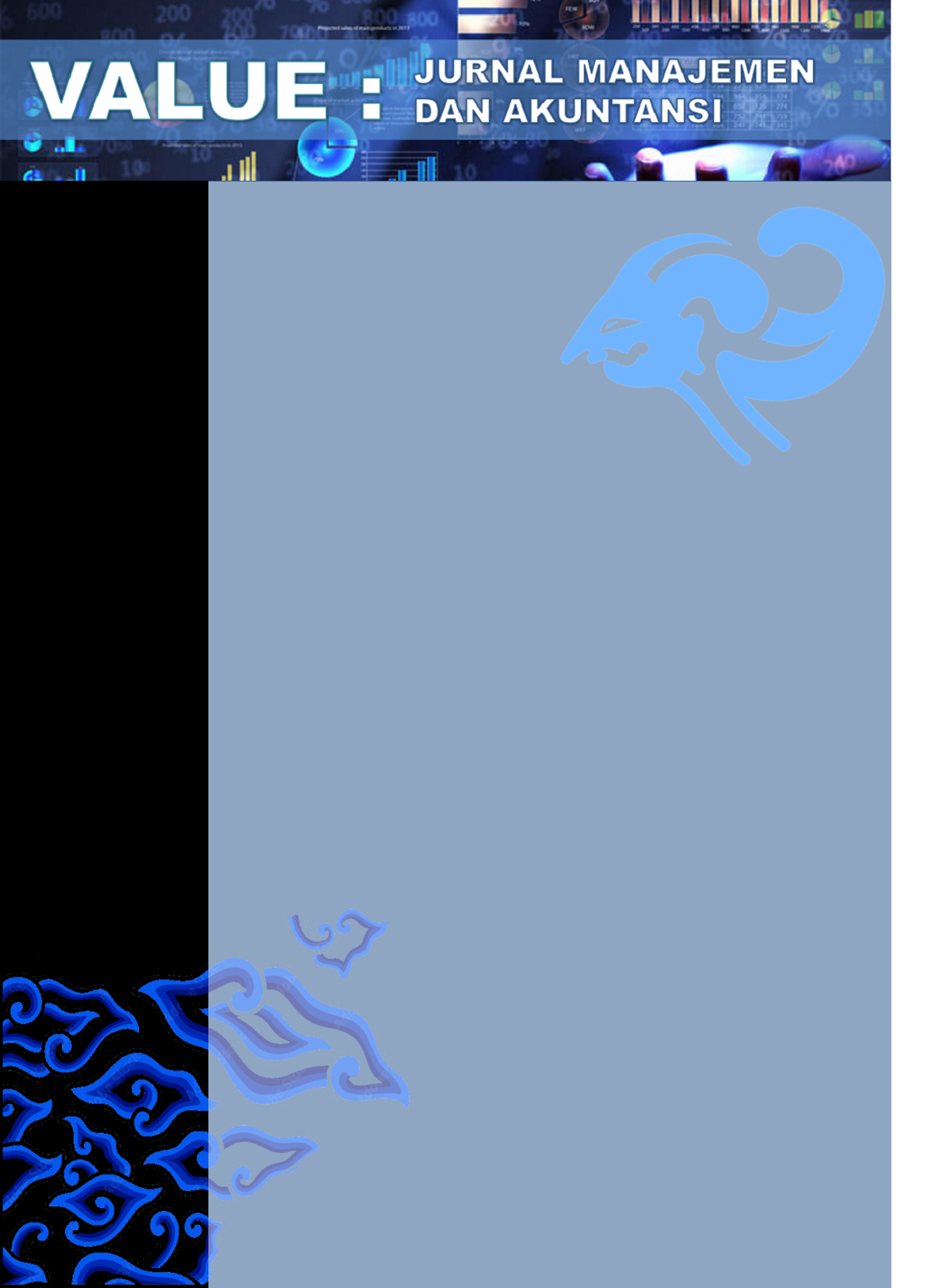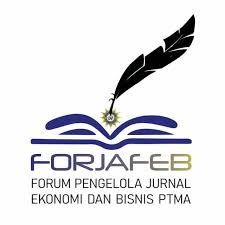Intensitas Aset Tak Berwujud Memoderasi Pengaruh Modal Intelektual Terhadap Profitabilitas Perusahaan Teknologi
DOI:
https://doi.org/10.32534/jv.v19i2.5491Keywords:
Intellectual Capital, VAIC, Intangible Asset Intensity, Profitability, Technology SectorAbstract
In the era of knowledge-based economy, the utilization of intellectual capital is very important for the value creation process to increase the profitability of the firm. Therefore, this study aims to examine the effect of intellectual capital on profitability with intangible asset intensity as a moderating variable. Quantitative method with simple and multiple linear regression analysis is used to test the research hypothesis. The population of this study consist of 22 technology firms listed on the Indonesia Stock Exchange (IDX) during the period 2019-2022. The pooled sample was taken using purposive sampling which amounted to 68 firm-year observations. Intellectual capital in this study is measured using Value-Added Intellectual Coefficient (VAIC) while profitability is measured by Return on Asset (ROA). The results of first hypothesis testing are in accordance with the initial prediction that intellectual capital (VAIC) has a positive effect on the profitability of technology sector firms on the IDX. However, the results of the second hypothesis testing are different from the initial prediction because intangible asset intensity does not moderate (strengthen) but instead moderates (weakens) the positive effect of intellectual capital (VAIC) on profitability. This means that the greater the value of intangible asset intensity in the statement of financial position, the smaller the positive effect of VAIC on profitability.
References
Alfraih, M. M. (2018). Intellectual capital reporting and its relation to market and financial performance. International Journal of Ethics and Systems, 34(3), 266–281. https://doi.org/10.1108/IJOES-02-2017-0034
Aybars, A., & Öner, M. (2022). The impact of intellectual capital on firm performance and value: An application of MVAIC on firms listed in Borsa Istanbul TT - Entelektüel sermayenin firma performans? ve de?eri üzerindeki etkisi: Borsa ?stanbul’da listelenen firmalar için MVAIC uygulam. Gazi ?ktisat ve ??letme Dergisi, 8(1), 47–60. https://doi.org/10.30855/gjeb.2022.8.1.004
Bagna, E., Ramusino, E. C., & Denicolai, S. (2021). Innovation through patents and intangible assets: Effects on growth and profitability of european companies. Journal of Open Innovation: Technology, Market, and Complexity, 7(4). https://doi.org/10.3390/joitmc7040220
Barney, J. B. (1986). Organizational Culture: Can It Be a Source of Sustained Competitive Advantage? The Academy of Management Review, 11(3), 656–665. https://doi.org/10.2307/258317
Barney, J. B., Ketchen, D. J., Wright, M., Barney, J. B., Ketchen, D. J., & Wright, M. (2011). The Future of Resource-Based Theory: Revitalization or Decline? Journal of Management, 37(5), 1299–1315. https://doi.org/10.1177/0149206310391805
Barney, J. B., & Mackey, A. (2016). Text and metatext in the resource-based view. Human Resource Management Journal, 26(4), 369–378. https://doi.org/10.1111/1748-8583.12123
Barney, J., Wright, M., & Ketchen, D. J. (2001). The resource-based view of the firm: Ten years after 1991. Journal of Management, 27(6), 625–641. https://doi.org/10.1016/S0149-2063(01)00114-3
Berzkalne, I., & Zelgalve, E. (2014). Intellectual Capital and Company Value. Procedia - Social and Behavioral Sciences, 110, 887–896. https://doi.org/10.1016/j.sbspro.2013.12.934
Bontis, N. (2001). Assessing knowledge assets: a review of the models used to measure intellectual capital. International Journal of Management Reviews, 3(1), 41–60. https://doi.org/10.1111/1468-2370.00053
Cillo, V., Petruzzelli, A. M., Ardito, L., & Del Giudice, M. (2019). Understanding sustainable innovation: A systematic literature review. Corporate Social Responsibility and Environmental Management, 26(5), 1012–1025. https://doi.org/https://doi.org/10.1002/csr.1783
Del Giudice, M., Scuotto, V., Garcia-Perez, A., & Messeni Petruzzelli, A. (2019). Shifting Wealth II in Chinese economy. The effect of the horizontal technology spillover for SMEs for international growth. Technological Forecasting and Social Change, 145, 307–316. https://doi.org/10.1016/j.techfore.2018.03.013
Dženopoljac, V., Janoševic, S., & Bontis, N. (2016). Intellectual capital and financial performance in the Serbian ICT industry. Journal of Intellectual Capital, 17(2), 373–396. https://doi.org/10.1108/JIC-07-2015-0068
Edvinsson, L., & Sullivan, P. (1996). Developing a model for managing intellectual capital. European Management Journal, 14(4), 356–364. https://doi.org/10.1016/0263-2373(96)00022-9
Fija?kowska, J. (2014). Value Added Intellectual Coefficient (VAICTM) as a Tool of Performance Measurement. Przedsiebiorczosc i Zarzadzanie, 15(1), 129–140. https://doi.org/10.2478/eam-2014-0010
Haji, A. A., & Ghazali, N. A. M. (2018). The role of intangible assets and liabilities in firm performance: Empirical evidence. Journal of Applied Accounting Research, 19(1), 42–59. https://doi.org/10.1108/JAAR-12-2015-0108
Iazzolino, G., Laise, D., & Migliano, G. (2014). Measuring value creation: VAIC and EVA. Measuring Business Excellence, 18(1), 8–21. https://doi.org/10.1108/MBE-10-2013-0052
Inkinen, H. (2015). Review of empirical research on intellectual capital and firm performance. Journal of Intellectual Capital, 16(3), 518–565. https://doi.org/10.1108/JIC-01-2015-0002
Jordão, R. V. D., & Novas, J. C. (2017). Knowledge management and intellectual capital in networks of small- and medium-sized enterprises. Journal of Intellectual Capital, 18(3), 667–692. https://doi.org/10.1108/JIC-11-2016-0120
Joshi, M., Cahill, D., Sidhu, J., & Kansal, M. (2013). Intellectual capital and financial performance: an evaluation of the Australian financial sector. Journal of Intellectual Capital, 14(2), 264–285. https://doi.org/10.1108/14691931311323887
Julienti Abu Bakar, L., & Ahmad, H. (2010). Assessing the relationship between firm resources and product innovation performance. Business Process Management Journal, 16(3), 420–435. https://doi.org/10.1108/14637151011049430
Khairiyansyah, K., & Vebtasvili, V. (2018). Relationship between Intellectual Capital with Profitability and Productivity in Indonesian Banking Industry. Jurnal Keuangan Dan Perbankan, 22(1), 127–136. https://doi.org/10.26905/jkdp.v22i1.1577
Kianto, A., Ritala, P., Vanhala, M., & Hussinki, H. (2020). Reflections on the criteria for the sound measurement of intellectual capital: A knowledge-based perspective. Critical Perspectives on Accounting, 70, 102046. https:/doi.org/10.1016/j.cpa.2018.05.002
Kor, Y. Y., & Mahoney, J. T. (2004). Edith Penrose’s (1959) Contributions to the Resource-based View of Strategic Management. Journal of Management Studies, 41(1), 183–191. https://doi.org/10.1111/j.1467-6486.2004.00427.x
Kulkarni, M., & Vijayakumar Bharathi, S. (2020). Intellectual capital in information technology companies in India: An impact study on firm performance. International Journal of Information Systems in the Service Sector, 12(4), 36–59. https://doi.org/10.4018/IJISSS.2020100103
Lehenchuk, S., Zeytinoglu, E., Hrabchuk, I., Zhalinska, I., & Oleksich, Z. (2023). Nexus Between Intellectual Capital, Financial Performance and Sustainable Growth: Evidence from the Turkish ICT Industry. Marketing and Management of Innovations, 4(1), 88–100. http://dx.doi.org/10.21272/mmi.2023.2-14
Lehenchuk, S. F., Vakaliuk, T. A., Nazarenko, T. P., Kubaš?íková, Z., & Juhászová, Z. (2023). The impact of intangible assets on the financial performance of Slovak ICT companies: a panel data regression analysis. under Creative Commons License Attribution 4.0 International (CC BY 4.0). 61–81. Retrieved from https://ceur-ws.org/Vol-3465/paper08.pdf
Li, H., & Wang, W. (2014). Impact of Intangible Assets on Profitability of Hong Kong Listed Information Technology Companies. Business and Economic Research, 4(2), 98. https://doi.org/10.5296/ber.v4i2.6009
Lobova, S. V, Alekseev, A. N., Litvinova, T. N., & Sadovnikova, N. A. (2020). Labor division and advantages and limits of participation in creation of intangible assets in industry 4.0: humans versus machines. Journal of Intellectual Capital, 21(4), 623–638. https://doi.org/10.1108/JIC-11-2019-0277
Lopes, I. T., & Ferreira, C. F. P. (2021). Intangibles as innovative drivers for competitive businesses. International Journal of Business Innovation and Research, 24(2), 238–260. https://doi.org/10.1504/IJBIR.2021.112814
Marr, B., Schiuma, G., & Neely, A. (2004). The dynamics of value creation: mapping your intellectual performance drivers. Journal of Intellectual Capital, 5(2), 312–325. https://doi.org/10.1108/14691930410533722
Mohamed, M., Murray, A., & Mohamed, M. (2010). The role of information and communication technology (ICT) in mobilization of sustainable development knowledge: a quantitative evaluation. Journal of Knowledge Management, 14(5), 744–758. https://doi.org/10.1108/13673271011074872
Mondal, A., & Ghosh, S. K. (2012). Intellectual capital and financial performance of Indian banks. Journal of Intellectual Capital, 13(4), 515–530. https://doi.org/10.1108/14691931211276115
Natalicchio, A., Ardito, L., Savino, T., & Albino, V. (2017). Managing knowledge assets for open innovation: a systematic literature review. Journal of Knowledge Management, 21(6), 1362–1383. https://doi.org/10.1108/JKM-11-2016-0516
Oliveira, L., Lima Rodrigues, L., & Craig, R. (2010). Intellectual capital reporting in sustainability reports. Journal of Intellectual Capital, 11(4), 575–594. https://doi.org/10.1108/14691931011085696
Öner, M., Aybars, A., Çinko, M., & Avc?, E. (2021). Intellectual Capital, Technological Intensity and Firm Performance: The Case of Emerging Countries. Scientific Annals of Economics and Business, 68(4), 459–479. https://doi.org/10.47743/SAEB-2021-0026
Orhangazi, Ö. (2019). The role of intangible assets in explaining the investment–profit puzzle. Cambridge Journal of Economics, 43(5), 1251–1285. https://doi.org/10.1093/cje/bey046
Peteraf, M. A. (1993). The Cornerstones of Competitive Advantage: A Resource-Based View. Strategic Management Journal, 14(3), 179–191. Retrieved from http://www.jstor.org/stable/2486921
Powell, T. C., & Dent-Micallef, A. (1997). Information technology as competitive advantage: the role of human, business, and technology resources. Strategic Management Journal, 18(5), 375–405. https://doi.org/10.1002/(SICI)1097-0266(199705)18:5<375::AID-SMJ876>3.0.CO;2-7
Pulic, A. (2000). VAICTM – an accounting tool for IC management. International Journal of Technology Management, 20(5–8), 702–714. https://doi.org/10.1504/IJTM.2000.002891
Pulic, A. (2004). Intellectual capital – does it create or destroy value? Measuring Business Excellence, 8(1), 62–68. https://doi.org/10.1108/13683040410524757
Qureshi, M. J., & Siddiqui, D. A. (2021). The Effect of Intangible Assets on Financial Performance, Financial Policies, and Market Value of Technology Firms: A Global Comparative Analysis. Asian Journal of Finance & Accounting, 12(1), 26. https://doi.org/10.5296/ajfa.v12i1.16655
Radoni?, M., Milosavljevi?, M., & Kneževi?, S. (2021). Intangible assets as financial performance drivers of it industry: Evidence from an emerging market. E a M: Ekonomie a Management, 24(2), 119–135. https://doi.org/10.15240/tul/001/2021-2-008
Salman, R. T. (2022). Intellectual Capital on Financial Performance of Nigerian Companies. Jurnal Administrasi Bisnis; Vol 11, No 2 (2022)DO - 10.14710/Jab.V11i2.44989 . Retrieved from https://ejournal.undip.ac.id/index.php/janis/article/view/44989
Sardo, F., & Serrasqueiro, Z. (2017). A European empirical study of the relationship between firms’ intellectual capital, financial performance and market value. Journal of Intellectual Capital, 18(4), 771–788. https://doi.org/10.1108/JIC-10-2016-0105
Serpeninova, Y., Lehenchuk, S., Mateášová, M., Ostapchuk, T., & Polishchuk, I. (2022). Impact of intellectual capital on profitability: Evidence from software development companies in the Slovak Republic. Problems and Perspectives in Management, 20(2), 411–425. https://doi.org/10.21511/ppm.20(2).2022.34
Shaban, M., & Kavida, V. (2013). Intellectual Capital, Financial Performance and Market Valuation: An Empirical Investigation of Information Technology Industry in India. Asia-Pacific Journal of Management Research and Innovation, 9(1), 55–62. https://doi.org/10.1177/2319510x13483512
Shaneeb, P., & Sumathy, M. (2021). Impact of Intellectual Capital on Firm Performance in Indian It Companies. Journal of Contemporary Issues in Business and Government, 27(02). https://doi.org/10.47750/cibg.2021.27.02.459
Smriti, N., & Das, N. (2018). The impact of intellectual capital on firm performance: a study of Indian firms listed in COSPI. Journal of Intellectual Capital, 19(5), 935–964. https://doi.org/10.1108/JIC-11-2017-0156
Suryani, A. W., & Nadhiroh, A. (2020). Intellectual Capital and Capital Structure Effect on Firms’ Financial Performances. Journal of Accounting Research, Organization and Economics, 3(2), 127–138. https://doi.org/10.24815/jaroe.v3i2.17258
Tiron Tudor, A., Dima (Cristea), S., & Dima, B. (2014). "The Linkage Between Intangibles And Profitability ". Annales Universitatis Apulensis Series Oeconomica, 1(16), 283–293. https://doi.org/10.29302/oeconomica.2014.16.1.25
Wernerfelt, B. (1984). A Resource-Based View of the Firm. Strategic Management Journal, 5(2), 171–180. Retrieved from http://www.jstor.org/stable/2486175
Xu, J., & Li, J. (2022). The interrelationship between intellectual capital and firm performance: evidence from China’s manufacturing sector. Journal of Intellectual Capital, 23(2), 313–341. https://doi.org/10.1108/JIC-08-2019-0189
Xu, J., & Wang, B. (2018). Intellectual Capital, Financial Performance and Companies’ Sustainable Growth: Evidence from the Korean Manufacturing Industry. In Sustainability (Vol. 10, Issue 12). https://doi.org/10.3390/su10124651
Zhang, N. (2017). Relationship between intangible assets and financial performance of listed telecommunication firms in China, based on empirical analysis. African Journal of Business Management, 11(24), 751–757. https://doi.org/10.5897/AJBM2017.8429


















